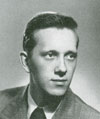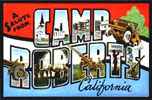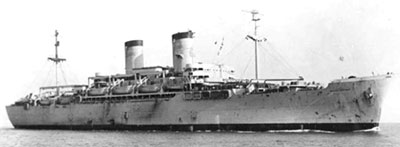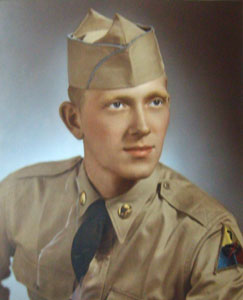 |
North
High School Wall of Honor
Charles Nelson Ritchie
Class of January, 1951 |
 |
 |
|
Research done by Claradell Shedd, class of 1953. |
| Charles Nelson Ritchie |
| Charles
graduated from North High in January, 1951. At the time, his next
of kin was Mrs. Blanche Ritchie, 703 15th Street, Des Moines,
IA. His service number was 55309813. |
|
| Charles Nelson Ritchie |
 |
| Year |
|
Rank |
|
Status |
 |
| January,
1951 |
|
Graduated |
x |
Graduated from North High,
Des Moines, IA |
| 1951-1952 |
|
Employed |
x |
Claims Agent; Bruce Motor Freight,
Des Moines, IA. |
| February3,1952 |
x |
Family |
x |
Married Esther L. Rowley,
North High Class of January, 1951. |
| Dec.8, 1952 |
x |
Drafted/
US Army
|
x |
Drafted into US Army in
Des Moines, IA
|
| date |
x |
Basic Training/
PVT;E1 |
x |
Camp Roberts, CA. *23rd
Infantry Regiment. 7th Armored Division. |
| June,1953 |
x |
Enroute |
x |
Troop transport bound
from San Francisco to Korea via **USS General John Pope (T-AP-110).
USS General John Pope (AP-110) was in Korea campaign from July
7-11, 1953. |
| July 19,1953 |
x |
Stationed |
x |
In Korea. 23rd Infantry Regiment.
Assigned to Regimental Headquarters in Korea, handling correspondence,
et. Camp was about 10 miles from the front. Could hear artillery
and see flares. Assigned to Motor Pool duties. Dispatcher: July
19, 1953. |
| Aug.17,1953 |
x |
Stationed |
x |
Assigned to Staff Section, S-1. Clerk.
Handled everything concerning personnel. |
| Dec,1953 |
x |
Hospitalized |
x |
***Contracted hemorrhagic fever,
which was a very serious disease. At that time, 2 our of 7 survived.
In 48th Hospital, Seoul, Korea. Recovered and went back to the
Regiment on February 24, 1954. During that period, they burned
all belongings such as camera, film pictures, clothing, etc. That
is why there are no photos of Charles during his field duty in
Korea. On a pass, he and friends woiuld go to Seoul. He was in
Japan on R&R. |
| Oct.12,1954 |
|
US Army/
Discharged/SFC |
x |
Fort Carson, CO. |
| 1954 |
x |
Transferred |
x |
Transferred to Army Reserve, Iowa
Military District to complete eight years of military service. |
| date |
x |
Employment |
x |
Worked at Armco Metal Products and
Pittsburgh Des Moines Steel. |
| date |
x |
Employment |
x |
Des Moines Steel Fence Company. |
| date |
x |
Civilian |
x |
Volunteered at Generation's delivering
meals to shut-ins. Died 06/27/06. |
|
|
*23th Infantry Regiment
In Korea the 23rd Infantry Regiment served initially as the “fire
brigade type unit” and was moved to counter enemy thrusts. Just
after the 2nd Infantry Division relieved the 24th Infantry Division
along the Naktong River, the communists attempted to overrun the Naktong
Line. The attack was stopped in the Changyong-Yongsan sector in a
battle, which lasted from the 1st to the 15th of September. Company
C was overwhelmed by a North Korean Division and ninety percent of
the Company was killed, wounded, or captured. The 23rd Infantry Regimental
Combat Team joined the other Combat Teams of the 2nd Infantry Division
and made a phenomenal break out of the perimeter against determined
resistance and chased the communists north and west. During the drive
north, the 23rd Infantry Regiment helped to liberate many of the prisoners’s
of war at Namwon Prison. Moving north in November, the Division had
advanced to within 50 miles of the Manchurian border when the Chinese
Communists entered the fight. Hoping to trap the Eighth Army northwest
of the Chongchon River, the Chinese attacked by the thousands. The
mission of the 23rd Infantry Regiment was to keep the withdrawal route
open over the Chongchon River and protect the right rear flank of
the Eighth Army. As the rear guard of the 2nd Infantry Division, the
Regiment suffered casualties amounting to nearly one-third of their
strength but performed its mission enabling the Eighth Army to withdraw
in order.
The Chinese winter offensive was halted at Wanju. From Kunu-ri to
Wonji the 23rd Infantry experienced 84 consecutive days of enemy contact,
the longest stint of combat of any regiment during the Korean War.
On 11 December, a French Battalion, Le Batallion De Coree, was attached
to the 23rd Infantry Regiment, for the battles of Twin Tunnels and
Chipyong. In the epic battle of Twin Tunnels, the 23rd Infantry Regimental
Combat Team routed the enemy at bayonet point and defeated two regiments
of the 125th Chinese Communist Division. At Chipyong-Ni, five enemy
divisions attacked the 23rd Infantry Regiment. Surrounded and outnumbered,
the Tomahawks defeated the Chinese, inflicting 5,000 casualties. The
battle marked a turning point in the war and was the first major defeat
suffered by the Chinese.
On April and May, the 2nd Infantry Division located on No Name Line
halted the communist spring offensive. Following a spectacular defensive
struggle against 10 enemy divisions the 2nd Infantry fought for 30
days before they secured the ridge. The communist attack to retain
control of Heartbreak Ridge lasted until the end of the following
month, when finally the Division was relieved for a well-earned rest.
Among the first divisions to see combat in World War II, the 24th
sustained minor casualties when the Japanese bombed Pearl Harbor on
7 December 1941. The division was charged with the defense of northern
Oahu, where it built an elaborate system of coastal defenses. In May
1943 the division was alerted for movement to Australia and by September
of that year, it had deployed to Camp Caves, near Rockhampton on the
eastern coast of Australia. The 24th was part of the assault forces
that landed on Dutch New Guinea, where it fought its way to the Hollandia
airfield. After occupation duty in the Hollandia area, the division
was among the assault forces on Leyte. From there the division went
to Luzon and eventually formed an element of the assault forces in
the Southern Philippines. During World War II the division adopted
its nickname, "Victory Division." After serving in five
campaigns and being decorated by the Philippine government, the 24th
left Mindanao on 15 October 1945 for occupation duty in Japan.
When the North Koreans attacked South Korea in June 1950, elements
of the 24th Infantry Division were the first to arrive in Korea, where
they fought a delaying action against overwhelming odds. The delay
permitted the United Nations to build up its forces near Pusan, and
the division was awarded the Presidential Citation (Army) for its
actions. Over the next nineteen months the division fought in seven
campaigns and was twice decorated by the Republic of Korea. In February
1952 the "Victory Division" returned to Japan where it served
as part of the Far East reserve. In July 1953 the division went back
to Korea to restore order in prisoner of war camps. The following
year the division returned to Japan, where it served until February
1955. At that time the 24th deployed to Korea for another tour of
duty.
When the United States reduced and realigned its divisions in the
Far East in 1957, the 24th left Korea, eventually replacing the 11th
Airborne Division in Germany. While in Germany, in addition to its
standard infantry mission, the 24th fielded airborne units for about
two years. The division remained in Germany until 1969 when it redeployed
to Fort Riley, Kansas, as part of the REFORGER (Return of Forces to
Germany) program. As the Army withdrew from Vietnam and reduced its
forces, the "Victory Division" was inactivated in April
1970 at Fort Riley.
|
 |
 |
| Basic
Training;Camp Roberts,CA |
Discharged;
Camp Carson, CO |
|
| USS General
John Pope (T-AP-110) - San Francisco to Korea |
 |
|
| coming: USS General John Pope;
T-AP-110Awards, Citations, and Campaign Ribbons |
 |
Top Row: American Campaign
Medal ; Asiatic-Pacific Campaign Medal (3)
Second Row: World War II Victory Medal; Navy Occupation Service
Medal (with Asia clasp); National Defense Service Medal
Third Row: Vietnam Service Medal (5); Philippine Liberation Medal
(2); Republic of Vietnam Campaign Medal |
|
**USS General
John Pope (T-AP-110)
After shakedown General John Pope sailed for Newport News 5 September
1943 with over 6,000 troops and civilians bound for Greenock, Scotland;
and, after disembarking her passengers there, returned to Norfolk, Virginia
25 September. From 6 October to 19 November she made a troop-carrying
voyage to Brisbane, Australia; and, after touching Townsville and Milne
Bay, put in at San Francisco on the latter date. Underway again 10 December
with over 5,000 troops for the Pacific fighting, General John Pope debarked
them at Noumea 23 December and returned via Pago Pago to San Francisco
10 January 1944 with 2,500 veterans.
In the months that followed, General John Pope sailed
in support of the giant amphibious offensive on New Guinea's northern
coast, spearheaded by Rear Admiral Barbey's famed VII Amphibious Force.
On a 3 month round-trip voyage out of San Francisco, beginning 23
January, she took troops to Guadalcanal, Auckland, and Noumea, and
brought 1,300 men back to San Francisco 9 March. General John Pope
then embarked another full complement of troops, including the 1st
Filipino Infantry Regiment, and sailed 6 April for Noumea and Oro
Bay, New Guinea.
Korea...
The spring of 1945 saw a round-trip troop-carrying
voyage begin in San Francisco 26 March, which took her to Manila,
Leyte, and Biak before returning 21 May. General John Pope next stood
out from the Golden Gate once more 2 June 1945, this time bound for
Marseilles, where 5,242 troops were embarked and taken to Manila.
Reinstated on the Navy List 20 July 1950, General John Pope was assigned
to MSTS 1 August. During the Korean War she carried American troops
to Japan and Korea to take part in the giant effort to hold back the
Communist invasion. Following the war, General John Pope continued
to sail to Japanese and Korean ports on troop rotation duties, finally
being placed in reduced operational status at Seattle 14 May 1955.
The veteran transport was returned to the Maritime Administration
(MARAD) and entered the National Defense Reserve Fleet at Olympia,
Washington, 5 September 1958.
***Hemorrhagic Fever during Korean War (48th Army Portable
Surgical Hospital, Seoul, Korea)
From online comments taken from: http://www.cbi-history.com/part_vi_48th_surgical_hosp.html
The viral hemorrhagic fevers (VHFs) are a diverse group of animal
and human illnesses that are caused by four distinct families of RNA
viruses: the Arenaviridae, Filoviridae, Bunyaviridae, and Flaviviridae.
All types of VHF are characterized by fever and bleeding disorders
and all can progress to high fever, shock and death in extreme cases.
Some of the VHF agents cause relatively mild illnesses, such as the
Scandinavian nephropathia epidemica, while others, such as the African
Ebola virus, can cause severe, life-threatening disease.
The 48th was called to duty again during the Korean
War when on Nov. 24, 1952, the 8228th Mobile Army Surgical Hospital
was redesignated the 48th Mobile Army Surgical Hospital.
Mary T. Burley began serving with the 48th as a nurse
in April 1953 just northwest of Seoul. She served with the unit for
15 months, treating mostly soldiers suffering from hemorrhagic fever.
"The first patient I saw who went on the artificial kidney was
near death," Burley recalled. "The next morning he sat up
in bed and read a magazine!"
Stan McCluskey was also part of the 48th in Korea.
He began serving with the unit in June 1953. "I was sent to the
48th MASH as the only person in the pharmacy. This was already a large
hospital, qualifying for evac hospital status. But processing was
slow, and we were only staffed as a MASH unit -- at least the pharmacy.
I was on duty or on call 24 hours a day, seven days a week.
"The 48th MASH was considred a very elite unit
with top quality personnel," McCluskey recalled. "There
was a lot of concern working with patients who had a disease of unknown
origin or cure [hemorrhagic fever]. Everyone took their responsibilities
very seriously and there were no complaints about the long hours."
Hemorrahagic fever is now often referred to as "Korean
hemorrhagic fever with renal syndrome." It is classed as one
of the hantaviruses. The virus is carried by field mice and passed
to humans via the mice's dried excreta. The disease produces a wide
range of symptoms including headache, nausea, sore throat, blood seepage
from weakened vascular walls, delirium, kidney failure and fluid accumulation
in the lungs.
|


|
Charles
Nelson Ritchie
Sergeant First Class
23rd Infantry Regiment
7th Armored Division
US Army


Charles Nelson Ritchie
|

 |

United Nations Service Medal/Korea; Korean War
Service Medal;
Korean Defense Service Medal w/Bronze Star; National Defense Medal;
Army Commendation Medal; Good Conduct Medal
|
|
|
|
| 11/23/10:
Died 06/27/06. |
| Music:
"Wind Beneath My Wings" |
Home
|
Back/allyears |
WWI |
WWII |
Korea |
Vietnam |
Afghanistan/Iraq |
Lyrics
|
Refs/Awards |
Contact
©2025-csheddgraphics All rights reserved.
All images and content are © copyright of their respective copyright
owners. |
|











